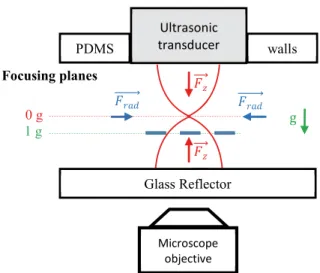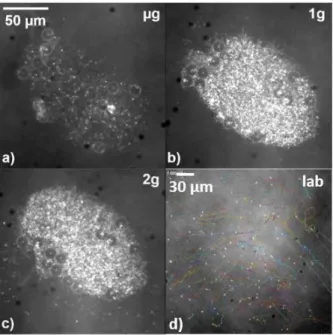HAL Id: hal-02376725
https://hal.archives-ouvertes.fr/hal-02376725
Submitted on 22 Nov 2019
HAL is a multi-disciplinary open access
archive for the deposit and dissemination of
sci-entific research documents, whether they are
pub-lished or not. The documents may come from
teaching and research institutions in France or
abroad, or from public or private research centers.
L’archive ouverte pluridisciplinaire HAL, est
destinée au dépôt et à la diffusion de documents
scientifiques de niveau recherche, publiés ou non,
émanant des établissements d’enseignement et de
recherche français ou étrangers, des laboratoires
publics ou privés.
Acoustic propulsion of metallic nano-cylinders:
contribution of the local vertical acceleration from micro
to hyper gravity
G Dumy, X Benoit-Gonin, M Hoyos, Jean-Luc Aider
To cite this version:
G Dumy, X Benoit-Gonin, M Hoyos, Jean-Luc Aider. Acoustic propulsion of metallic nano-cylinders:
contribution of the local vertical acceleration from micro to hyper gravity. 26th European Low Gravity
Research Association Biennial Symposium and General Assembly, Sep 2019, Granada, Spain.
�hal-02376725�
HAL Id: hal-02376725
https://hal.archives-ouvertes.fr/hal-02376725
Submitted on 22 Nov 2019
HAL is a multi-disciplinary open access
archive for the deposit and dissemination of
sci-entific research documents, whether they are
pub-lished or not. The documents may come from
teaching and research institutions in France or
abroad, or from public or private research centers.
L’archive ouverte pluridisciplinaire HAL, est
destinée au dépôt et à la diffusion de documents
scientifiques de niveau recherche, publiés ou non,
émanant des établissements d’enseignement et de
recherche français ou étrangers, des laboratoires
publics ou privés.
Acoustic propulsion of metallic nano-cylinders:
contribution of the local vertical acceleration from micro
to hyper gravity
Jean-Luc Aider, G Dumy, X Benoit-Gonin, M Hoyos
To cite this version:
Jean-Luc Aider, G Dumy, X Benoit-Gonin, M Hoyos. Acoustic propulsion of metallic nano-cylinders:
contribution of the local vertical acceleration from micro to hyper gravity. 26th European Low Gravity
Research Association Biennial Symposium and General Assembly, Sep 2019, Granada, Spain.
�hal-02376725�
26th European Low Gravity Research Association Biennial Symposium and General Assembly
14th International Conference on "Two-Phase Systems for Space and Ground Applications”
European Space Agency Topical Teams meetings
Granada (Spain), September 24-27, 2019
133. Acoustic propulsion of metallic nano-cylinders: contribution of the local vertical acceleration from micro to hyper gravity
26thEuropean Low Gravity Research Association Biennial Symposium and General Assembly
14thInternational Conference on "Two-Phase Systems for Space and Ground Applications”
European Space Agency Topical Teams meetings
Granada (Spain), September 24-27, 2019
Acoustic propulsion of metallic nano-cylinders: contribution of the local
vertical acceleration from micro to hyper gravity
G. Dumy1,2, X. Benoit-Gonin, M. Hoyos1, J-L. Aider2
1PMMH Lab, ESPCI Paris, Paris Sciences et Lettres, Sorbonne Universités, Paris, France 2 Université Paris Descartes, Paris, France
gabriel.dumy@espci.fr, mauricio.hoyos@espci.fr, jean-luc.aider@espci.fr
Introduction
Acoustic manipulation of microscopic objects can be performed using ultrasonic standing wave resonators and is called acoustophoresis. Provided that the wavelength of the acoustic field (generated in this case by a piezoelectric transducer) and that one of the cavity dimension h verify = 2h, an ultrasonic stationary wave can be generated between two opposite walls of said cavity. This field can have two effects on the cavity components: on scattering particles it will exert a net body force on scattering particles, and it will transfer momentum to the fluid filling the cavity resulting in a streaming flow. Thus, a suspension of microscopic objects submitted to such a field will see its constituents driven towards the pressure nodes (or antinodes depending on particles properties), where they can be trapped. The typical size of the objects that can be moved by acoustophoresis ranges usually from 500 nm to several tens of microns.
A surprising finding in ultrasonic manipulation of micron-sized objects is the auto-propulsion of metallic nano-cylinders when trapped in such a field (Wang et al. 2012): instead of aggregating like spherical particles, they start to swim while being confined in the pressure node of the acoustic field. The phenomenon has first been described with gold nano-cylinders (1µm long and 200nm in diameter). Trajectories ranging from straight lines to circular trajectories is observed. It is an intriguing phenomenon, since these quite small particles can propel up to hundredth of sizes per seconds (Ahmed et al 2016), while while moving into a Re ~ 10-4 flow
(see Figure 2. d) ). In addition, these particles can organize themselves in chains hundredth of microns long because of their rotation, showing interesting self-assembling properties. Moreover, the power levels used here are on par with medical echography devices, and these nanorods have proven to be active even in cells, showing interesting potential for bio-oriented applications. In the present work we investigated the contribution of the local acceleration of the gravity field on the orientation of the nano-cylinders, and its potential role in the propulsion of these objects.
Reorientation of metallic nano-cylinders under different vertical accelerations
Indeed, in standard gravity conditions, the aggregating position differs from the geometrical pressure node because of the equilibrium between the acoustic force and buoyant forces, which are non-negligible for metallic particles. As depicted on Figure 1, for metallic particles the aggregating plane is lower than the geometric center of the acoustic field. Calculations show that for gold microparticles with a typical acoustic energy of 10 to 100 J.m-3 under regular gravity, the
levitation plane is 5 to 10% lower than the pressure node.
Figure 1: Sketch of the acoustic resonant cavity. The cavity height
is 200 µm leading to an acoustic resonant frequency fac = 3.65 MHz. The cavity upper wall is directly the quarter-wave layer of a packaged transducer, embedded in PDMS walls. When the ultrasounds are turned on the micro-rods gather at the equilibrium focusing plane and form a swarming cluster. The equilibrium focusing plane is lower than the nodal plane because of the gravity. The distance from the nodal plane is larger for high-density micro-rods, like gold micro-rods. In micro-gravity, the micro-rods are expected to gather in the nodal plane.
Thus, we carried out a micro-gravity experiments campaign, to test the influence of the local vertical acceleration, and thus the effect of the vertical aggregating position on the behavior of our objects.
Figure 2 presents a striking feature of our findings. An aggregate of gold nano-cylinders is formed under a 3.65 MHz acoustic field, and its behavior during the 1g and 2g phases of the experiment is comparable to what we observe in the laboratory. However, as soon as we start the microgravity phase, its appearance changes. It becomes darker, which we interpreted as a reorientation of the nano-rods. Indeed, in every acoustic propulsion of these objects we know of, the long axis of the rods is always parallel to the observation plane, which leads to the visualization of bright nanorods. Since we mostly perform reflection observation experiments, these objects always appear brighter than the background. However, if one considers that the rod long axis is now perpendicular to the observation plane, then the effective are reflecting the light becomes much smaller, leading to a darker object. Focusing planes PDMS Glass Reflector walls 0 g 0 g 1 g
26th European Low Gravity Research Association Biennial Symposium and General Assembly
14th International Conference on "Two-Phase Systems for Space and Ground Applications”
European Space Agency Topical Teams meetings
Granada (Spain), September 24-27, 201926thEuropean Low Gravity Research Association Biennial Symposium and General Assembly
14thInternational Conference on "Two-Phase Systems for Space and Ground Applications”
European Space Agency Topical Teams meetings
Granada (Spain), September 24-27, 2019
Figure 2: Visualizations of a large aggregate of self-propelled
micro-rods in acoustic levitation in micro-gravity (a), 1 g (b) and hyper-gravity (c). The large circles observed in the aggregates are 15 micrometers polystyrene particles that were used to find the equilibrium positions of aggregates before the experiment, and that were not completely washed by the buffer. (d) In standard gravity conditions, the micro-rods are self-propelled by the ultrasounds once they have reached the acoustic levitation plane. Here, micro cylinders of pure gold (1µm length, ~200 nm radius) are propelled in a 3.6 MHz acoustic field, with an acoustic energy density of 25 J.m-3. Tracks denoting their trajectories over a few seconds are plotted in color, propulsion velocities typically reach ~30 µm.s-1.
A contribution of the transversal acoustic radiation force component?
Why should these objects change orientation when the vertical acceleration changes? An interesting additional observation, as denoted before, is that in every visualization we know of, the rods present their long axis parallel to the aggregation plane. Up to now, this observation has been taken for granted. Our experiments show that this is in fact not trivial, and can be explained only if they are forced to do so by the vertical component of the acoustic radiation force. As
the vertical component of the acoustic force vanishes in the nodal plane of the resonator (Whitworth et al 1991, Tuziuti et al 1999), only the transverse one remains, which will then force the rods to reorient themselves along the observation axis.
The vertical position of aggregation for these high-density objects seems then to have a role to play in their acoustic response, a hypothesis that has not been much considered before. It also means that the orientation and propulsion is linked to the transverse component of the acoustic field, which is a hypothesis currently under investigation.
Conclusion
We compared laboratory and microgravity experiments, to correlate between the vertical position of the aggregate and the propulsion speed of the swimmers. We observed a different behavior of the cylinders in each case, which leads to reconsidering the classic hypothesis used to study self-acoustophoresis. This result suggests that the transverse component of the acoustic force plays an important role in the propulsion mechanism of these objects.
Acknowledgements
We would like to thank the foundation Bettencourt and the doctoral school FIRE for funding Gabriel Dumy’s PhD.
References
W. Wang, L.A. Castro, M. Hoyos, T.E. Mallouk, Autonomous motion of metallic microrods propelled by ultrasound, ACS
Nano, 6, 7, 6122 (2012).
S. Ahmed, W. Wang, L. Bai, D.T. Gentekos, M. Hoyos, T.E. Mallouk, Density and Shape Effects in the Acoustic Propulsion of Bimetallic Nanorod Motors, ACS Nano 10, 4, 4763 (2016).
G. Whitworth, M.A. Grundy, W.T. Coakley, Transport and harvesting of suspended particles using modulated ultrasound,
Ultrasonics, 29, 439 (1991).
T. Tuziuti, T. Kozuka, H. Mitome, Measurement of distribution of acoustic radiation force perpendicular to sound beam axis, Japanese journal of applied physics, 38, 3297 (1999).

